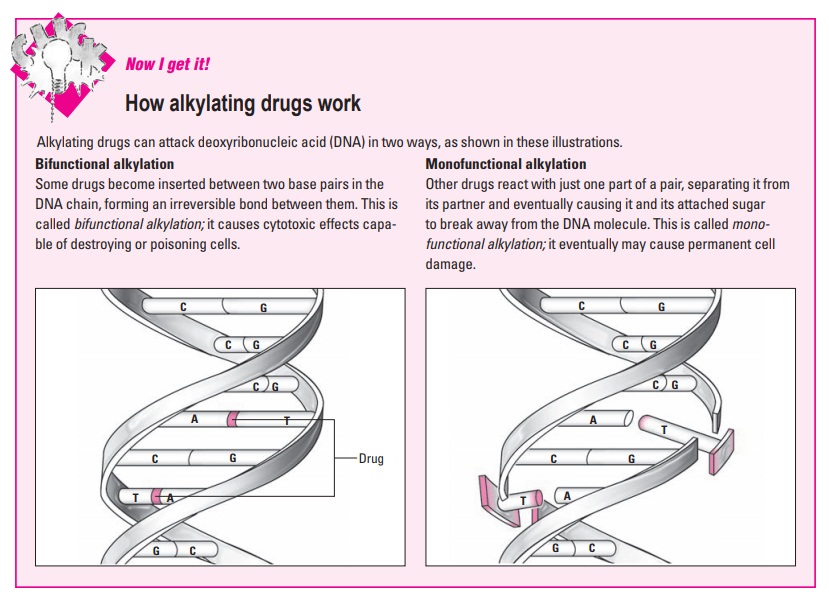Chapter: Clinical Pharmacology: Antineoplastic drugs
Nitrogen mustards
Nitrogen mustards
Nitrogen mustards represent the largest group of
alkylatingdrugs. They include:
·
chlorambucil
·
cyclophosphamide
·
estramustine
·
ifosfamide
·
mechlorethamine hydrochloride
·
melphalan.
First and fast
Mechlorethamine hydrochloride was the first
nitrogen mustard in-troduced and is rapid-acting.
Pharmacokinetics (how drugs circulate)
The absorption and distribution of nitrogen
mustards, as with most alkylating drugs, vary widely.
Metabolism and excretion
Nitrogen mustards are metabolized in the
liver and excreted by the kidneys. Mechlorethamine undergoes metabolism so
rapidly that no active drug remains after a few minutes. Most nitrogen mustards
possess more intermediate half-lives than mechloreth-amine.
Pharmacodynamics (how drugs act)
Nitrogen mustards form covalent bonds with DNA molecules in a chemical
reaction known as alkylation.
Alkylated DNA can’t repli-cate properly, thereby resulting in cell death.
Unfortunately, cellsmay develop resistance to the cytotoxic effects of nitrogen
mus-tards. (See How alkylating drugs work.)
Pharmacotherapeutics (how drugs are used)
Because they produce leukopenia (reduced number of white blood cells [WBCs]), the nitrogen mustards are effective in treat-ing malignant neoplasms, such as Hodgkin’s disease (cancer caus-ing painless enlargement of the lymph nodes, spleen, and lym-phoid tissues) and leukemia (cancer of the blood-forming tissues), that can have an associated elevated WBC count.
Nitrogen bomb
Nitrogen mustards also prove effective against
malignant lym-phoma (cancer of the lymphoid tissue), multiple myeloma (cancer
of the marrow plasma cells), melanoma (malignancy that arisesfrom melanocytes),
and cancers of the breast, ovaries, uterus, lung, brain, testes, bladder, prostate,
and stomach.
Drug interactions
Nitrogen mustards interact with a wide variety of
other drugs:
·
Calcium-containing drugs and foods, such as antacids and dairy products,
reduce absorption of estramustine.
·
Cyclophosphamide taken with cardiotoxic drugs produces additive cardiac
effects.
·
Cyclophosphamide may reduce serum digoxin levels.
·
An increased risk of ifosfamide toxicity exists when the
·
drug is taken with allopurinol, barbiturates, chloral hydrate, or
phenytoin.
·
Corticosteroids reduce the effects of ifosfamide.
·
The lung toxicity threshold of carmustine may be reduced when taken with
melphalan.
·
Interferon alpha may reduce serum concentration of mel-phalan. (See Adverse reactions to nitrogen mustards.)

Related Topics